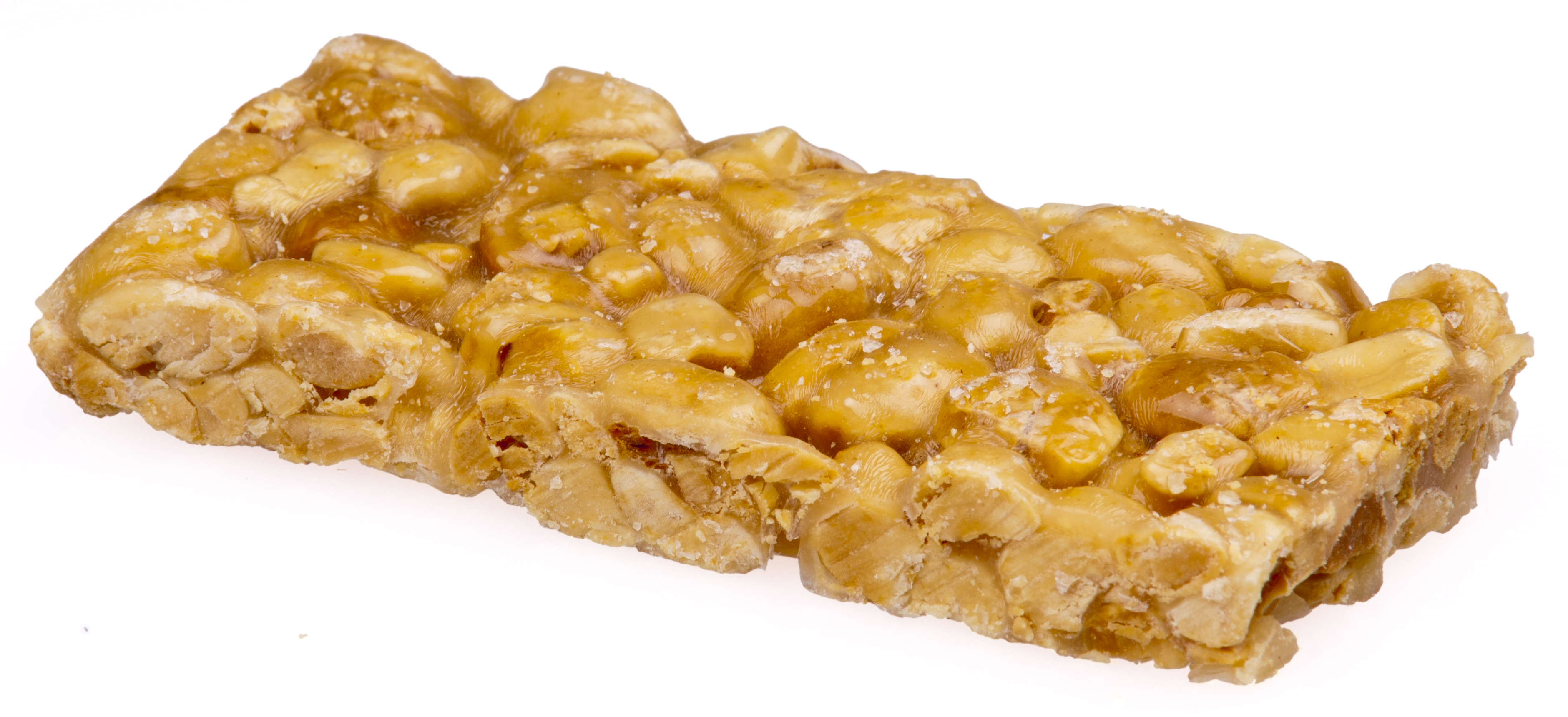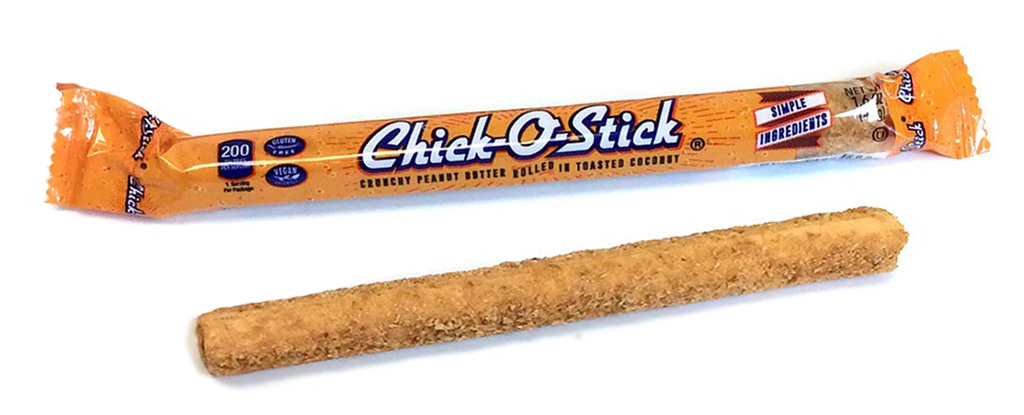|
Candybar
A candy bar is a type of candy that is in the shape of a bar. The most common type of candy bar is the chocolate bar, including both bars made of solid chocolate and combination candy bars, which are candy bars that combine chocolate with other ingredients, such as nuts, caramel, nougat, or wafers. Many varieties of candy bars exist, and many are mass-produced. Between World War I and the middle of the 20th century, approximately 40,000 brands of candy bars were introduced. Chocolate bars A chocolate bar is a bar-shaped piece of chocolate, which may also contain layerings or mixtures of other ingredients. A wide variety of chocolate bar brands are sold. A popular example is a Snickers bar, which consists of nougat mixed with caramel and peanuts. The first solid chocolate bar was produced by Fry's of Bristol, England in 1847. Fry's Chocolate Cream became the first mass-produced chocolate bar in 1866. The Goo Goo Cluster was the first mass-produced combination bar ... [...More Info...] [...Related Items...] OR: [Wikipedia] [Google] [Baidu] |
Caramac Bar (cropped)
Caramac is the brand name for a caramel-based confectionery that was created by Mackintosh's, and is now manufactured by Nestlé. It was first introduced in the United Kingdom in 1959. The name is derived from the syllabic abbreviation of ''Caramel'' and ''Mackintosh''. A similar confection is used in the covering of McVitie's Gold biscuit bar. A limited edition Caramac Kit Kat bar was released in the United Kingdom in 2005 and due to popular demand it was brought back in 2007. In 2015 a buttons version was launched. History The name of the product was determined in a competition. The competition was held in what was the Norwich factory of Mackintosh's, and won by Barbara Herne. The bar was made at the old Norwich factory until its closure in 1996, when production transferred to Fawdon on Tyneside, where it is still made. Design The bar is a light brown colour and is manufactured using sweetened condensed milk, butter, various flavouring A flavoring (or flavouring), ... [...More Info...] [...Related Items...] OR: [Wikipedia] [Google] [Baidu] |
Salted Nut Roll
Salted Nut Roll is a candy bar made by the Pearson's Candy Company of Saint Paul, Minnesota and is available in the Midwestern United States. Description It has a nougat center that is surrounded in a layer of caramel and then covered with salted Virginia peanuts. Pearson's use of reduced lactose whey makes this confection easier to digest for lactose-sensitive individuals. The Salted Nut Roll is available in a variety of sizes and has had chocolate-covered limited editions and there have been non-seasonal spin-off products such as the Salted Pecan Roll. Seasonal editions include Spicy, Cinnamon Churro, Apple Pie, and Pumpkin Spice History The Salted Nut Roll was introduced by Pearson's during the Great Depression in 1933, a year after the PayDay A pay day or payday is a specified day of the week or month when one is paid, usually workers collecting wages from their employers. Pay Day, PayDay or Payday may also refer to: Arts, entertainment, and media Films * ''Pay Day' ... [...More Info...] [...Related Items...] OR: [Wikipedia] [Google] [Baidu] |
PayDay (confection)
PayDay (stylized as "PAYDAY") is a brand of a candy bar first introduced in 1932 by the Hollywood Candy Company. The original PayDay candy bar consists of salted peanuts rolled over a nougat-like sweet caramel center. Since 1996, classic PayDay candy bars without chocolate have been continually produced by The Hershey Company. In 2020, Hershey's released a "Chocolatey PayDay bar" as a permanent part of the PayDay product line; it is identical to the regular bar, but covered by a layer of chocolate. History PayDay was first introduced in 1932 by Hollywood Candy Company and got its name because it was first produced on pay day at the company. PAYDAY was marketed during the Great Depression as a meal replacement because of its dense peanut outer layer. Headed by Frank Martoccio, who had founded the F.A. Martoccio Macaroni Company, Hollywood also produced the ZERO bar, originally called the Double Zero when first released in 1920. In 1938, Hollywood moved to Centralia, Illinois. In ... [...More Info...] [...Related Items...] OR: [Wikipedia] [Google] [Baidu] |
Munch (candy Bar)
Munch is a peanut bar manufactured by Mars, Incorporated and sold in the United States. The bar was introduced in 1970 as the Snickers Munch Peanut Brittle Bar and was later relabeled "Munch". It is made of only seven ingredients: peanuts, sugar, butter, corn syrup, palm oil, salt and soy lecithin. The candy bar contains no chocolate and is comparable to peanut brittle Brittle is a type of confection consisting of flat broken pieces of hard sugar candy embedded with nuts such as pecans, almonds, or peanuts, and which are usually less than 1 cm thick. Types It has many variations around the world, such as '' ..., though the Munch bar has a higher density of peanuts compared to most brittles. Due to its short list of simple ingredients, it is marketed as being healthy and natural. References External links Official website {{Mars confectionery products Candy bars Mars confectionery brands Products introduced in 1970 ... [...More Info...] [...Related Items...] OR: [Wikipedia] [Google] [Baidu] |
Mantecol
Mantecol is the brand name of a typical dessert of the cuisine of Argentina,Murió Odysseas Georgalos, el creador del imperio dulce dueño de Mantecol by AGUSTINA DEVINCENZI, Cronista.com, 7 May 2021 a sort of semi-soft made from . It was originally created and marketed in the 1940s by the confectionery company Georgalos, founded by a Greek immigrant, Miguel Georgalos, who took the inspiration in a dessert of Greek cuisine, the '' |
Laffy Taffy
Laffy Taffy is an American brand of taffy candies produced by the Ferrara Candy Company, a subsidiary of Ferrero. The candies are small (about ), individually wrapped taffy rectangles available in a variety of colors and artificial fruit flavors, including banana, strawberry, green apple, grape, blueberry, watermelon, blue raspberry, and cherry. Rarer flavors include caramel apple, coconut, strawberries & cream, apple crisp, chocolate mousse, pumpkin donut, pineapple, guava, orange sorbet, and lemon raspberry. Discontinued flavors include fruit punch, mango, strawberry banana, peppermint, and hot cocoa. The name "Laffy Taffy" refers to both the texture of the taffy as well as its embodiment of silliness: short, question-and-answer-style jokes are printed on the outside of each wrapper, such as "What do you call a cow with no legs? – Ground beef." Some jokes are pun-based, such as "What is Labor Day? – That's when mommies have their babies." Others are based on silly ... [...More Info...] [...Related Items...] OR: [Wikipedia] [Google] [Baidu] |
Choo Choo Bar
A Choo Choo Bar is a brittle toffee liquorice-flavoured confectionery bar popular in Australia. Available in a bar, packaged in a blue wrapper depicting an old steam train, ("The Choo Choo Funtime Express"), Choo Choo Bars were originally a Plaistowe product, acquired by Nestlé. They are now made by Lagoon. There is also a raspberry-flavoured Choo Choo Bar. Cultural context The Choo Choo Bar is considered iconic. Choo Choo Bars are considered to be part of the Australian folklife. Academic work refers to Choo Choo Bars in this manner referring to prior Federal Governmental inquiry outcomes: They are considered to have an elevated status within Australian folklife, and are used when setting historical context. Choo Choo Bars are used as a specific reference to make a point about Australian food, culture, or lifestyle. History Plaistowe released the original Choo Choo Bar in Western Australia, in the mid 1950s. In the 1980s, Choo Choo Bars became unavailable. Lagoon Con ... [...More Info...] [...Related Items...] OR: [Wikipedia] [Google] [Baidu] |
Caramac
Caramac is the brand name for a caramel-based confectionery that was created by Mackintosh's, and is now manufactured by Nestlé. It was first introduced in the United Kingdom in 1959. The name is derived from the syllabic abbreviation of ''Caramel'' and ''Mackintosh''. A similar confection is used in the covering of McVitie's Gold biscuit bar. A limited edition Caramac Kit Kat bar was released in the United Kingdom in 2005 and due to popular demand it was brought back in 2007. In 2015 a buttons version was launched. History The name of the product was determined in a competition. The competition was held in what was the Norwich factory of Mackintosh's, and won by Barbara Herne. The bar was made at the old Norwich factory until its closure in 1996, when production transferred to Fawdon on Tyneside, where it is still made. Design The bar is a light brown colour and is manufactured using sweetened condensed milk, butter, various flavouring A flavoring (or flavouring), ... [...More Info...] [...Related Items...] OR: [Wikipedia] [Google] [Baidu] |
Carambar
Carambar is a brand of chewy caramel candy from France, owned by Eurazeo. History In 1954, Mr. Fauchille, director of the Delespaul-Hazard company, and Mr. Gallois, an employee, had a surplus of cocoa and decided to create a new, original recipe to use it up. The legend says that one of the machines in the factory was malfunctioning, making the long bars that still exists today. This sweet, in the form of a bar was named Caram'bar. Each of the original Caram'bars were a regulated size and weight. The statistics are as follows: * Length: 7 cm * Weight: 10 g * Recommended retail price: 5 centimes * Wrapper: Yellow, with red striped twisted ends Inside of the wrappers, there were "Carambar points" which could be redeemed for various Carambar-related products until 1961, when points were replaced by jokes. Carambar is famous for the poor quality of these jokes, and the expression ''blague Carambar'' (french: Carambar joke) refers to a bad or childish joke. In 1972, the nam ... [...More Info...] [...Related Items...] OR: [Wikipedia] [Google] [Baidu] |
Bit-O-Honey
Bit-O-Honey is an American candy product; it first appeared in 1928 and was made by the Schutter-Johnson Company of Chicago, Illinois. Bit-O-Honey was a new kind of candy bar consisting of six pieces wrapped in waxed paper and then packaged in a cover wrapper. The candy consists of almond bits embedded in a honey-flavored taffy, which makes for a long-chewing candy. Both a large bar and a small, bite-sized version are available for sale, the latter in bags of multiple units. In 1969, Schutter-Johnson was merged into the Blumenthal Brothers Chocolate Company, Ward Candy Company of New York City, makers of other candies, including Oh Henry! and Chocolate-covered raisin, Raisinets. Between the mid- and late-1970s, a chocolate-flavored version called Bit-O-Chocolate was made, but this product was later dropped. Other spin-offs included Bit o' Licorice and Bit-O-Peanut Butter. In 2017, Bit-O-Honey Chocolate was reintroduced. Bit-O-Honey and Ward's other brands were acquired by C ... [...More Info...] [...Related Items...] OR: [Wikipedia] [Google] [Baidu] |



